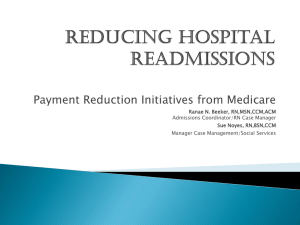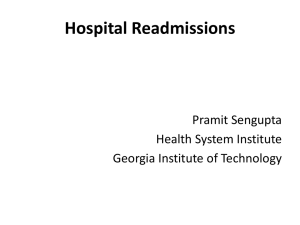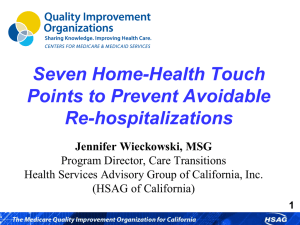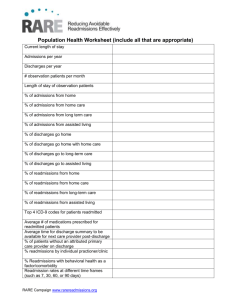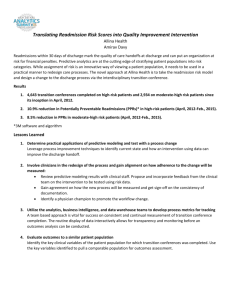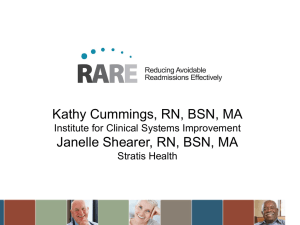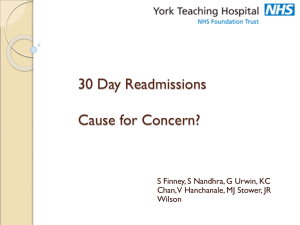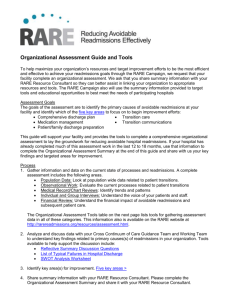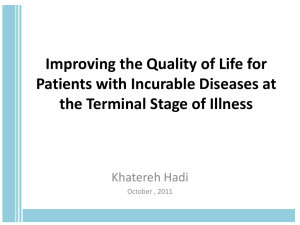Pre-work Packet - Maryland Hospital Association
advertisement
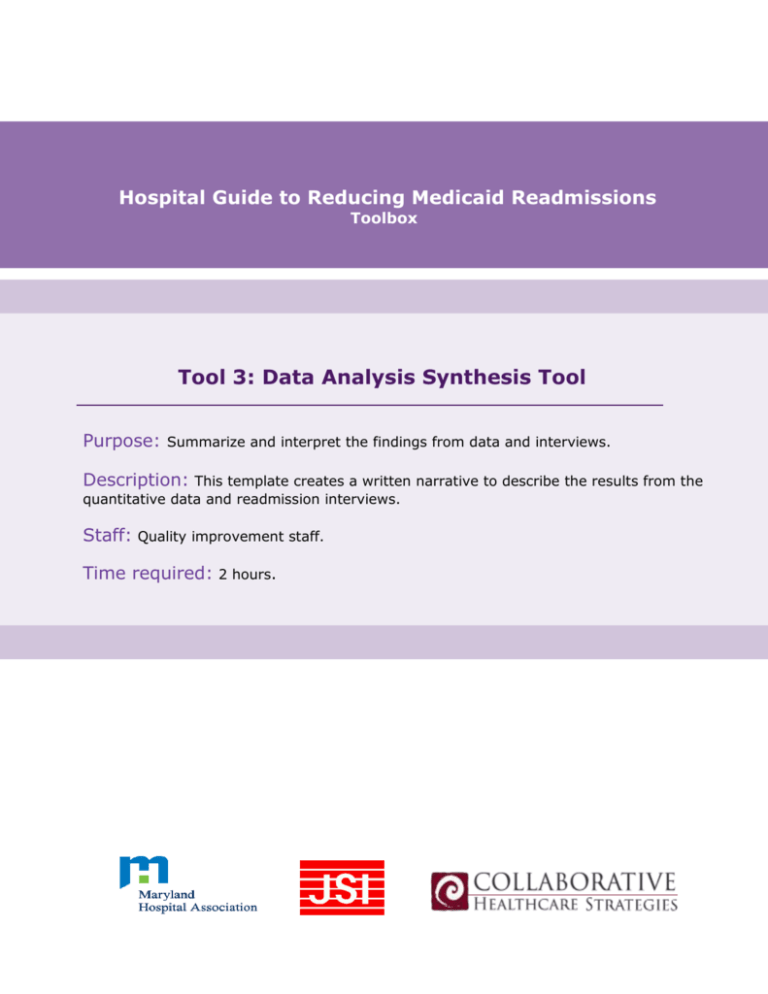
Hospital Guide to Reducing Medicaid Readmissions Toolbox Tool 3: Data Analysis Synthesis Tool Purpose: Summarize and interpret the findings from data and interviews. Description: This template creates a written narrative to describe the results from the quantitative data and readmission interviews. Staff: Quality improvement staff. Time required: 2 hours. Tool 3: Data Analysis Synthesis Tool [Hospital Name] Readmission Analysis General Summary From [month, year] to [month, year], there were [#] total adult, nonobstetric discharges from [Hospital Name], excluding those who were discharged deceased or transferred to another acute care hospital. Of this total, there were [#] Medicare discharges (% of total), [#] Medicaid discharges (% of total), [#] commercial discharges (% of total), and [#] uninsured/self-pay discharges (% of total). There were [#] 30‐day readmissions. This yields an all‐payer, all‐cause 30‐day readmission rate for [Hospital Name] of #%. The Medicaid readmission rate is #%, the Medicare readmission rate is #%, and the uninsured readmission rate is #%. Note, the [payer, likely Medicaid] population has the highest 30‐day readmission rate of all payer‐defined subgroups. Of all of the readmissions at Hospital Name, #% (n=#) were Medicaid readmissions; #% (n=#) were Medicare readmissions; and #% (n=#) readmissions were among uninsured patients. Table 1. Adult (nonobstetric) discharges and readmissions by Medicare and Medicaid Payer All Patients Medicare Medicaid (adult, nonobstetric) # % (#/Total # 30-day % (#/Total Readmission Rate Discharges Discharges) 100 Readmissions Readmissions) (#Readm/#Discharges) 100 Number of days between discharge and readmission Of all readmissions, % (n=#) of all readmissions occurred within 4 days of discharge; and #% (n=#) occurred within 10 days of discharge. This suggests [enter observation about the timing of post-hospital followup and services]. Discharge disposition # (%) of Medicaid patients were discharged to home; # (%) were discharged to home health care, and # (%) were discharged to SNF. In contrast, # (%) of Medicare patients were discharged to home, # (%) were discharged to home health care, and # (%) were discharged to SNF. Table 2. Distribution of discharge disposition by Medicare and Medicaid Measure Discharge to home Discharge to home health Discharge to skilled nursing facility Medicare Page 1 of 4 Hospital Guide to Reducing Medicaid Readmissions Medicaid Top diagnoses associated with readmissions The diagnoses associated with the highest numbers of readmissions include: Diagnosis 1 (#), Diagnosis 2 (#); Diagnosis 3 (#); Diagnosis 4 (#); … and Diagnosis 10 (#). Together, the top 10 diagnoses account for a total of # readmissions, #% of total readmissions. The top 10 readmission diagnoses by payer are listed below. Notable similarities include [list similar diagnoses here]; notable differences include [list differences here]. Chronic conditions, such as [heart failure, heart disease, diabetes, list] make up (#) on this list. Acute conditions, such as [sepsis, urinary tract infection, gastroenteritis, list] make up (#) on this list. Complications make up (#) on this list. There are (#) behavioral health‐related diagnoses. Table 3. Top discharge diagnoses resulting in readmission Medicare Medicaid 1. 2. 3. 4. 5. 6. 7. 8. 9. 10. 1. 2. 3. 4. 5. 6. 7. 8. 9. 10. The top 10 diagnoses leading to readmissions accounted for (x%) of all Medicare readmissions and (y%) of all Medicaid readmissions. This suggests that [a small percentage of all readmissions are identified by relying only primary diagnoses]. High‐utilizing population There were # people hospitalized three or more times at our hospital in the past 12 months. These # people used # hospitalizations, which is an average of # per person. There were # readmissions, yielding a readmission rate of #%. Among the high-utilizing population, #% were discharged to home without services, #% were discharged to home health, and #% were discharged to a skilled nursing facility. [Make observation about diagnoses, whether similar or different than overall readmission population]. Table 4: High utilizers # People People hospitalized 3 times People hospitalized 4 times People hospitalized 5 times People hospitalized 6 times People hospitalized 7 times Continue until max Total Average hospitalizations/person (# hospitalizations/# people) Total # people Page 2 of 4 Hospital Guide to Reducing Medicaid Readmissions # Hospitalizations Total# hospitalizations Readmission interview findings To supplement the insights derived from data analyses, we interviewed # recently readmitted Medicaid patients. The table provides a summary of the patients’ readmission circumstances. Table 5. Summary of readmission interviews st 1 Hospitalization Age, sex, chief complaint, length of stay, discharge diagnosis, discharge disposition Patient 2 Patient 3 Patient 4 Patient 5,, etc. nd 2 Hospitalization Patient’s words why returned, whether he/she had posthospital follow-up # Days to Readmission Days between discharge and readmission Notes Opportunities for improvement Summary of patient perspectives about being readmitted: [Summarize what patients said about why they returned to the hospital, whether it is disappointing/reassuring to them, whether this represents “good” care or not, whether they felt rushed, confused, had questions after discharge, whether their doctor told them to return, etc.] Analysis of patients’ perspectives about being readmitted: What do the patient comments suggest about: The discharge process, including timing and perceived readiness? The educational or written materials? Whether teach-back is being targeted effectively (e.g., target to caregiver)? Whether “whole‐person” needs are being identified? Whether referrals for supports and follow-up are being made before discharge? Whether there is any collaboration with post-acute or community providers? Whether patients view readmissions as “bad” or “o.k.”? What does that suggest for our efforts to educate patients, caregivers, and the public about effective transitions in care? Summary of family/caregiver perspectives about being readmitted: [Summarize the family/caregiver perspectives about returning to the hospital. You may note that often family/caregivers are more able/willing to offer criticism.] Page 3 of 4 Hospital Guide to Reducing Medicaid Readmissions Analysis of family/caregiver perspectives about being readmitted: [What did you learn from this feedback that can inform improvement activities?] Summary of providers’ perspectives about readmitted patients: [Summarize what providers said about readmitted patients, including whether the provider knew the patient had been readmitted, whether the provider had any insights about what could have avoided a readmission, and whether the provider had any suggestions for general improvement.] Analysis of provider feedback: What does the provider feedback suggest about: Whether providers know when their patient is readmitted? Whether providers view readmissions as potentially preventable? Whether provider education or engagement is warranted? Page 4 of 4 Hospital Guide to Reducing Medicaid Readmissions AHRQ Hospital Guide to Reducing Medicaid Readmissions Toolbox Tool 13: Community Resource Guide Purpose: Develop an updated resource guide of community resources relevant to providing post-hospital supports and services to avert readmissions. Description: This tool is modeled on a community resource guide developed by a community-based care management agency. It prompts the hospital readmission reduction team to identify specific contacts at community agencies to facilitate efficient referrals to services. Staff: Hospital readmission team, cross-continuum team. Time required: 10 hours. Hospital Guide to Reducing Medicaid Readmissions Tool 13: Community Resource Guide The first step to using community resources to address patients’ social and behavioral health needs is to identify community agencies and other organizations that can help meet those needs. Many hospitals perceive that there are limited or no community resources available, without ever having made a concerted effort to look for these resources. This tool will help you populate a resource guide to quickly and efficiently connect patients to the services they need. Starting on the next page is a template to fill in the information about your community resources. This resource guide will be especially helpful to the discharge coordinators, community health workers, patient advocates, volunteers, or other people who will help patients address their basic needs. Once completed, an abbreviated version of the most common referrals/resources used can be added to the Whole-Person Assessment Tool. To populate this resource guide, draw from the following information sources: 1. Your cross-continuum team partners. A highly useful function of your cross-continuum team is to ask them to help populate an inventory of community-based services that can meet the clinical and nonclinical needs of Medicaid patients after hospitalization. Their knowledge and experience with these services will help in creating efficient linkages to care from the hospital. 2. Key contacts at Medicaid health plans. Representatives from Medicaid health plans should be invited to the cross-continuum team meetings, but depending on geography, they may not be able to attend in person as the local service providers can. A clinical/quality leader at the hospital (e.g., director of quality) should identify a key contact at each Medicaid health plan who can update and clarify the types of supports and services the plan can provide and for which types of patients. Most important, the hospital and each plan should develop a clinical (not just utilization review) point of contact to facilitate time-sensitive discussions about posthospital supports and services to reduce readmissions. 3. Your hospital social workers. Social workers are trained to understand the comprehensive landscape of social services in a community. Over time, hospital-based social workers may benefit from inservices or networking with community-based colleagues to refresh connections and understanding of available programs and resources, as this is a continuously changing landscape in any community. 4. A search engine. Conducting an online search for community resources in your area can be a quick way to find potential partners and their contact information. This can be a useful research method in addition to what the social workers and cross-continuum team partners are aware of. 5. 2‐1‐1. Most of the United States has access to 2-1-1, a telephone hotline that specializes in health and human services information and referral. This can also be a useful supplemental method of research for hard-to-find community resources. Page 1 of 4 Hospital Guide to Reducing Medicaid Readmissions 7 Resource Guide for [Hospital Name] Health Clinics Name/Contact Person [Community Clinic A] [Mental Health Center B] [Health Department C] [Sickle Cell Foundation D] [AIDS Health Center E] [Community Dental Clinic F] [Dental School G] Phone Number [555-555-5555] Address [123 Street, City] [555-555-5555] [123 Street, City] [555-555-5555] [123 Street, City] [555-555-5555] [123 Street, City] [555-555-5555] [123 Street, City] [555-555-5555] [123 Street, City] [555-555-5555] [123 Street, City] Assistance Offered Substance Abuse Treatment Name/Contact Person [Alcoholics Anonymous A] [Narcotics Anonymous B] [Methadone Clinic C] [Recovery Home D] Phone Number [555-5555555] [555-5555555] [555-5555555] [555-5555555] Address [123 Street, City] Assistance Offered [123 Street, City] [123 Street, City] [123 Street, City] Housing and Rent Assistance Name/Contact Person [Religious Organization A] [Housing Authority B] [Community Agency C] [Women and Children’s Services D] [Temporary Shelter E] Phone Number [555-5555555] Address [123 Street, City] [555-5555555] [555-5555555] [555-5555555] [123 Street, City] [555-5555555] [123 Street, City] Assistance Offered [123 Street, City] [123 Street, City] Page 2 of 4 Hospital Guide to Reducing Medicaid Readmissions 8 Financial Assistance Name/Contact Person [Community Assistance Program A] [Charity B] [Religious Organization C] [Salvation Army D] [Employment Office E] [Career Center F] Phone Number [555-5555555] [555-5555555] [555-5555555] [555-5555555] [555-5555555] [555-5555555] Address [123 Street, City] Assistance Offered [123 Street, City] [123 Street, City] [123 Street, City] [123 Street, City] [123 Street, City] Food Assistance Name/Contact Person [Community Assistance Program A] [Charity B] [Meals on Wheels C] [Salvation Army D] [Religious Organization E] [Career Center F] Phone Number [555-5555555] [555-5555555] [555-5555555] [555-5555555] [555-5555555] [555-5555555] Address [123 Street, City] Assistance Offered [123 Street, City] [123 Street, City] [123 Street, City] [123 Street, City] [123 Street, City] Nonemergent Transportation Assistance Name/Contact Person [Cab Company A] [VA Clinic B] [Community Agency C] Phone Number [555-5555555] [555-5555555] [555-5555555] Address [123 Street, City] [123 Street, City] [123 Street, City] Page 3 of 4 Hospital Guide to Reducing Medicaid Readmissions Assistance Offered Nonmedical Home Care Agencies Name/Contact Person [Home Care Agency A] [Community Agency B] Phone Number [555-5555555] [555-5555555] Address [123 Street, City] Assistance Offered [123 Street, City] Legal Assistance Name/Contact Person [Medical Legal Partnership A] [Company B] [Community Agency C] Phone Number [555-5555555] [555-5555555] [555-5555555] Address [123 Street, City] Assistance Offered [123 Street, City] [123 Street, City] Children’s Services Name/Contact Person [Immunization Agency A] [Religious Organization B] [Parenting Assistance Group C] [Early Development Services D] [Community Daycare Services E] [Children’s Insurance Program F] [YMCA/YWCA G] Phone Number [555-5555555] [555-5555555] [555-5555555] [555-5555555] [555-5555555] [555-5555555] [555-5555555] Address [123 Street, City] Assistance Offered [123 Street, City] [123 Street, City] Medicaid Assistance Name/Contact Person [Medicaid Customer Service Office A] Phone Number [555-5555555] Address [123 Street, City] Page 4 of 4 Hospital Guide to Reducing Medicaid Readmissions Assistance Offered Hospital Guide to Reducing Medicaid Readmissions Toolbox Tool 12: Cross-Continuum Team How To Tool Purpose: To advise and assist with the formation of a cross-continuum team. Description: This tool explains the benefits and process of building a crosscontinuum team and offers a template for inviting partners to join it. Staff: Quality improvement leadership, cross-continuum team. Time required: N/A; tool used for informing how to convene this team of variable size. Hospital Guide to Reducing Medicaid Readmissions Tool 12: Forming a Cross-Continuum Team By definition, a transition involves a “sending” (referring) and “receiving” (accepting) provider. Remember that the best transition out of your setting is only as good as the reception into the next setting of care. Forming a cross‐continuum team has several concrete and practical benefits. Some of the immediate benefits include: Declare to your referral partners your organization’s readmission reduction goals; Describe the range of efforts your organization is implementing to reduce readmissions; Understand what your cross-setting referral partners are doing to reduce readmissions; Understand what information your receivers need to facilitate a safe and stable transition into their setting to avoid a readmission; Form and strengthen multidisciplinary relationships among providers who share the care of common patients (putting a face to a name); and Identify partners that will help your hospital achieve quality, satisfaction, and/or cost goals. Forming a cross‐continuum team does not need to represent a major new strategic business decision. Cross‐continuum teams start with the providers with whom you commonly share high-risk patients. Acknowledge that not all possible partners are at the table, and allow the group to expand naturally over time. Once you start hosting cross-continuum team meetings, other providers will want to be included. An example email/letter of invitation for new members of your cross-continuum team is on the following page. Keep it simple, and send the emails today. Use Tool 5, the Cross-Continuum Inventory Tool, to identify providers and agencies to invite. As you expand your readmission reduction efforts to include adult Medicaid patients, consider reaching out to the following: Medicaid managed care organizations Medicaid behavioral health carve-out plans Medicaid agencies, especially in a fee-for-service market Behavioral health providers, community mental health, crisis teams Substance abuse treatment providers Home health agencies that serve high-volume Medicaid and/or behavioral health patients Physician practices that serve high-volume Medicaid patients, including community health centers Social service agencies, including those that provide social work services Elder service agencies, including those identified as aging and disability resource centers Pharmacies that provide bedside delivery and/or medication counseling services Adult day health programs Local emergency departments that share the care of common frequent users Page 1 of 4 Hospital Guide to Reducing Medicaid Readmissions Community Partnership Meeting [Your Organization Here] Readmission Reduction Project Dear Colleagues, [Your Organization] invites you to join us at the launch of our first cross-continuum team meeting to improve care transitions and reduce avoidable readmissions on [Date] from xx-xx at [location]. [Your Organization] is committed to high-quality, safe care, including at times of transition between care settings. [Your Organization] has embraced the priorities of the national Partnership for Patients and has recently made reducing avoidable readmissions through improving care a top quality initiative. Our aim is to reduce readmissions by [x%] over the next 12 months. We know that our success depends on strong partnerships with you, the providers with whom we share the care of patients in the greater [your city/county name] community. To that end, we are hosting an open “cross-continuum” meeting among hospitals, skilled nursing facilities, home health agencies, aging and social service providers, assisted living facilities, primary care practices, pharmacies, and other interested stakeholders. We hope to foster an active and highly productive community-based coalition of providers working in alignment toward a common goal of safe transitions in care for our shared patients. Please join us. We will be [serving lunch] during a working meeting. Please come for all or part of the meeting. If you are not available, we would welcome a colleague from your organization. We look forward to working together toward the improved care of our patients in [your community]. Please do not hesitate to contact me with any questions. Kind regards, [You - the readmission reduction champion at your organization] Page 2 of 4 Hospital Guide to Reducing Medicaid Readmissions Example Cross-Continuum Team Workplan Collaborating with cross-continuum providers is a specific and action-oriented strategy to improve transitions in care. Productive cross-continuum collaboration requires fostering a team culture of engagement, commitment to shared goals, transparency, and shared learning. If you are convening—or reinvigorating—a cross-continuum team, the first several meetings are appropriately spent in introducing individuals and learning about providers’ efforts to improve transitions (through direct service delivery, facilitating access to services, financing services, accessing data, mobilizing existing resources, etc.). Experience suggests that a trusting, collaborative environment of open feedback, shared problem solving, and improvement can be established within the first two or three regular meetings of a cross-continuum team. Establishing a shared action agenda is essential for engaging sustained participation in cross-continuum team efforts and for converting good intentions into demonstrable improvements in transitions between settings and providers. There are numerous potential actions for a cross-continuum team; the specifics are determined by your local partnerships, your high-risk populations of interest, and the strengths of the change agents you have convened. Your cross-continuum team can—and should—make improvements in several domains in parallel process, such as improving cross-setting handoffs, developing efficient referral pathways for community-based services, and reviewing and sharing readmission data across organizations. Below is an example cross-continuum team workplan, which organizes numerous specific actions into a smaller number of priority domains of focus. Assigning responsibility for leading, coordinating, or reporting at future meetings engages a diverse membership in coproducing the agenda and work of this team. The last page of this tool is an example from the field of a cross-continuum team agenda and minutes. Domain Causes of Readmissions Community Resources and Capabilities Timely Communication and Improved Handoffs Timely Referrals to Community Services Action Overview of recent papers or presentations about readmissions Discuss recently readmitted patient to identify opportunities for improvement Discuss hospital-specific readmission trending data All skilled nursing facilities complete INTERACT “Nursing Home Capabilities” Checklist All providers fill out their part of the “crosscontinuum team inventory” Group education on topic: Adult Day Health X ,Y,Z Community Services “Receiving providers” create a list of information that is frequently missing Hospital and primary care provider workgroup meet to discuss “executive summary” or “one-liner” options for real-time notification of issues at time of transition Task force on identifying how to refer hospitalized patients to the following on an urgent basis: Meals Transportation Transitional housing Behavioral health services Page 3 of 4 Hospital Guide to Reducing Medicaid Readmissions Person(s) Responsible Date Due Quarterly Every meeting Every meeting Within a month By next meeting Rapid‐fire presentations at Q2 meeting By next meeting 6-week task force to report back on [date] 6-week task to report back on [date] XXX Regional Medical Center Home Health, SNF, and Hospital Leaders Meeting Minutes Date: Time: Location: Facilitator: Note Taker: Timekeeper: Attendees: List names and organizations of all present. Domain Community Resources Topic Welcome/ Introductions [Specific Agency] Health Information Exchange HIE update – Home Health Readmission Data – Trending and Insights Readmission Data and Case Reviews by Facility/ Improved Handoffs Home Health Electronic Orders and Medication Reconciliation Form to SNF’s Discussion Leader Host Group Notes XX provided an overview of the community transition of care team roles and responsibilities for the [target] population. She discussed how the medication reconciliation process is a main focus of the transition of care team. The group discussed opportunities to strengthen relationships to improve transitions of care. XX reported that she has been working with XX and XX to get connected with [the local HIE]. They are waiting on a quote for needed equipment to do this. XX reported physician practices that are partnered with XX are also connecting with the local HIE. She stated that 28 practices in the community are connecting with the local HIE. Each facility and agency reported on their case review of the May readmissions (see attachments). Overall findings revealed that many patients are readmitted from SNF facilities due to family members insisting residents are sent to hospital when their condition changes. The group discussed possible ways to talk with families to help them understand options for residents versus immediately sending to hospital. XX also discussed the possibility of using Telehealth communication systems in SNF’s XX reported she will set‐up a meeting with Dr. XX and Hospital IT staff to discuss ways to get an electronic signature on the Home Health orders and to streamline the medication reconciliation forms with appropriate MD signatures. Meeting adjourned at 8:30 a.m. Next meeting scheduled for XXX. Page 4 of 4 Hospital Guide to Reducing Medicaid Readmissions Assignments XX welcomed everyone. XX will call the vendor to assist with getting the needed quote XX and Dr. XX will report at next meeting Hospital Guide to Reducing Medicaid Readmissions Toolbox Tool 7: Portfolio Design Tool Purpose: Develop a portfolio of strategies to reduce readmissions. Description: This tool prompts readmission reduction teams to expand readmission reduction efforts to include action in at least three broad domains: improve standard care for Medicaid patients, collaborate with partners, and provide enhanced services for highrisk patients. Staff: Readmission reduction champion, readmission team. Time required: 2-4 hours Hospital Guide to Reducing Medicaid Readmissions Tool 7: Portfolio Design Drawing on the information gathered from your data analyses, readmission interviews, and hospital‐specific and communitywide inventory of readmission reduction efforts, categorize the current individual actions into strategic themes (drivers of reducing Medicaid readmissions). The diagram below displays one approach to categorizing these different strategic themes. More information on the readmission reduction efforts in each strategic theme can be found in the guide (Sections 4, 5, and 6 correspond to the categories illustrated below). Instructions Use the table that follows to prompt a consideration of which readmission practices are in place at your hospital, including which are standard care for all patients versus just care for patients identified as high risk of readmission. Identify which practices should be added to expand your hospital’s strategy. Page 1 of 2 Hospital Guide to Reducing Medicaid Readmissions Improve Hospital‐Based Transitional Care Processes for Medicaid Patients Collaborate With Cross‐Setting Partners Provide Enhanced Services for High‐ Risk Patients Readmission reduction effort Flag patients who were recently discharged <30d in chart/electronic medical record Work in the emergency department to treat and avoid readmission Broaden view of readmission risks; assess “whole‐ person” needs Develop transitional care plans that consider needs over 30 days Ask patients and caregivers why they returned, if readmitted Ask patients and caregivers what help they need Use teach‐back; target the appropriate “learner” Customize information, and share information about readmission risk Arrange posthospital followup Use a checklist to reliably deliver complete transitional care for all patients Use admission, discharge, and transfer notifications with medical and behavioral health providers Ask community providers what information they need to assume care of patient Collaborate with community providers to arrange timely followup Perform “warm” handoffs, providing an opportunity for clarification Form a cross‐continuum team that can collaborate on care across settings Update staff awareness of social and behavioral health services and supports Broaden partners to include Medicaid health plans and their care managers Identify community partners with social work and behavioral health competencies Segment “high‐risk” patient needs—varying types of service and levels of intensity Provide enhanced multidisciplinary care team for high utilizers Provide short-term social work-based transitional care to reduce barriers to navigating and connecting to existing resources in the community Connect Medicaid managed care patients to care management services Connect behavioral health patients to integrated care managers Provide urgent care to populations with recurrent exacerbations (e.g. sickle cell, COPD) Increase appropriate referral to palliative care and hospice Develop cross‐provider, cross-setting individual care plans Page 2 of 2 Hospital Guide to Reducing Medicaid Readmissions Implemented Need To Add
